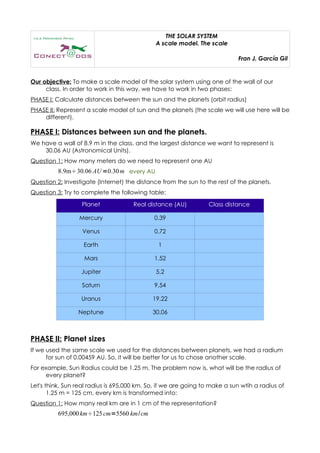101113 build solarsystem
•
0 likes•160 views
1) The document outlines a two-phase plan to create a scale model of the solar system using one of the classroom walls. 2) Phase I involves calculating the scale distances between the sun and each planet based on the wall length and the actual maximum distance between objects in the solar system. 3) Phase II will use a different scale to represent the actual sizes of each planet and the sun based on converting their real radii to radii that can be modeled on the classroom wall.
Report
Share
Report
Share
Download to read offline

Recommended
Recommended
More Related Content
What's hot
What's hot (19)
Viewers also liked (9)
NQC - 21 mẫu CV cho người tìm việc (2014) - Tái bản lần 1

NQC - 21 mẫu CV cho người tìm việc (2014) - Tái bản lần 1
Similar to 101113 build solarsystem
Similar to 101113 build solarsystem (20)
A light beam with velocity (1.16 mkm per sec), creates the solar system 

A light beam with velocity (1.16 mkm per sec), creates the solar system
Observational Parameters by Santosh Takale at MU Astro Basic (27-10-13).pdf

Observational Parameters by Santosh Takale at MU Astro Basic (27-10-13).pdf
Planet Velocity Is Defined As A Function Of Its Diameter (II)

Planet Velocity Is Defined As A Function Of Its Diameter (II)
The sun data shows relativistic effects and motions 

The sun data shows relativistic effects and motions
Recently uploaded
Recently uploaded (20)
DEV meet-up UiPath Document Understanding May 7 2024 Amsterdam

DEV meet-up UiPath Document Understanding May 7 2024 Amsterdam
CNIC Information System with Pakdata Cf In Pakistan

CNIC Information System with Pakdata Cf In Pakistan
Stronger Together: Developing an Organizational Strategy for Accessible Desig...

Stronger Together: Developing an Organizational Strategy for Accessible Desig...
Introduction to Multilingual Retrieval Augmented Generation (RAG)

Introduction to Multilingual Retrieval Augmented Generation (RAG)
The Zero-ETL Approach: Enhancing Data Agility and Insight

The Zero-ETL Approach: Enhancing Data Agility and Insight
WSO2's API Vision: Unifying Control, Empowering Developers

WSO2's API Vision: Unifying Control, Empowering Developers
Repurposing LNG terminals for Hydrogen Ammonia: Feasibility and Cost Saving

Repurposing LNG terminals for Hydrogen Ammonia: Feasibility and Cost Saving
Cloud Frontiers: A Deep Dive into Serverless Spatial Data and FME

Cloud Frontiers: A Deep Dive into Serverless Spatial Data and FME
Why Teams call analytics are critical to your entire business

Why Teams call analytics are critical to your entire business
Navigating the Deluge_ Dubai Floods and the Resilience of Dubai International...

Navigating the Deluge_ Dubai Floods and the Resilience of Dubai International...
Choreo: Empowering the Future of Enterprise Software Engineering

Choreo: Empowering the Future of Enterprise Software Engineering
Vector Search -An Introduction in Oracle Database 23ai.pptx

Vector Search -An Introduction in Oracle Database 23ai.pptx
AWS Community Day CPH - Three problems of Terraform

AWS Community Day CPH - Three problems of Terraform
JavaScript Usage Statistics 2024 - The Ultimate Guide

JavaScript Usage Statistics 2024 - The Ultimate Guide
101113 build solarsystem
- 1. THE SOLAR SYSTEM A scale model. The scale Fran J. García Gil Our objective: To make a scale model of the solar system using one of the wall of our class. In order to work in this way, we have to work in two phases: PHASE I: Calculate distances between the sun and the planets (orbit radius) PHASE II: Represent a scale model of sun and the planets (the scale we will use here will be different). PHASE I: Distances between sun and the planets. We have a wall of 8.9 m in the class, and the largest distance we want to represent is 30.06 AU (Astronomical Units). Question 1: How many meters do we need to represent one AU 8.9m÷30.06 AU =0.30m every AU Question 2: Investigate (Internet) the distance from the sun to the rest of the planets. Question 3: Try to complete the following table: Planet Real distance (AU) Class distance Mercury 0.39 Venus 0.72 Earth 1 Mars 1,52 Jupiter 5,2 Saturn 9,54 Uranus 19,22 Neptune 30,06 PHASE II: Planet sizes If we used the same scale we used for the distances between planets, we had a radium for sun of 0.00459 AU. So, it will be better for us to chose another scale. For example, Sun Radius could be 1.25 m. The problem now is, what will be the radius of every planet? Let's think. Sun real radius is 695,000 km. So, if we are going to make a sun wtih a radius of 1.25 m = 125 cm, every km is transformed into: Question 1: How many real km are in 1 cm of the representation? 695,000km÷125cm=5560 km/cm
- 2. Question 2: How many cm do we need to represent a real km 125cm/695,000km=0.000180cm/ km Question 3: Investigate (Internet) the radius of every planet. Question 4: Try to complete the following table: Planet Real diameter (km) Real radius (km) Class radius (cm) Sun 695 Mercury 4878 Venus 12104 Earth 12576 Mars 6787 Jupiter 142800 Saturn 120000 Uranus 51118 Neptune 49528 To be continued... with the mathematical use of scales